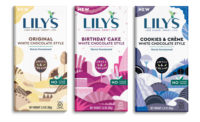
“Do as I say, but not as I do,” a phrase used by parents over several generations, could very well apply to America’s attitude toward healthy eating, a recent Nielsen/Natural Marketing Institute (NMI) report reveals.
“Health and Wellness in America” written by Sherry Frey, v.p. of Nielsen Perishables Group and Steve French, NMI managing partner, found that while three-quarters of Americans believe they can manage health issues through proper nutrition, 91 percent admit to snacking all day on candy, ice cream and chips.
So does eating healthy and unhealthy foods in equal measure balance out? Does this ying/yang approach to eating mean consumers can have their cake and carrot juice too? The report turns up some interesting findings. Consider the following:
- Personal Responsibility: 89 percent say taking personal responsibility for one's health is the best way to stay healthy (aspiration) but only 70 percent say they're actually "actively trying to be healthier" (behavior).
- Self management: 75 percent say they feel they can manage health issues through nutrition (aspiration) yet 50 percent say it's a challenge to eat healthy (behavior).
- Self control: 64 percent say they will take whatever means necessary to control their own health, but 66 percent say they don’t exercise enough and more than 50 percent say they “splurge” when dining out and yield to cravings.
- Grocery shopping: 50 percent of Americans say availability of organic or nutritionally enhanced products have no or next to no impact on their grocery purchases.
So why do we have this disconnect?
- Perception of price: 54 percent said healthy foods were too expensive to eat regularly
- Perception of taste: 50 percent said they were not willing to give up taste for health
Interestingly, this dichotomy doesn’t seem to prevent Americans from turning to functional foods as a substitute for medicines. Call it the “a little bit of sugar helps the medicine go down” approach.
The same Nielsen/NMI report reveals the following:
- Fortified foods: 66 percent of Americans said they had consumed fortified foods or beverages over the year.
- Nutrition: 75 percent of Americans believe they can manage many of their health issues through nutrition.
- Functional Foods: 33 percent said they believe functional foods and drinks can be substituted for some of the medicines they take.
- Americans are label-conscious: 73 percent of Americans said they had consumed high protein food and beverages in the past year.
- Millennials: 27 percent of Millennials are more responsive than the average to health packaging claims.
And finally, it’s important to note that not all consumers are alike. According to the report, consumers “differ in attitudes, purchase behavior and wellness orientation, requiring more focused approaches.”
Nielsen/NMI identified five mutually exclusive consumer segments: Well Beings (19 percent), Food Actives (18 percent), Magic Bullets (23 percent), Fence Sitters (20 percent) and Eat, Drink & Be Merrys (20 percent).
Each differs in value per basket ring, number of shopping trips per household as well as total money spent annually on food and drink. Surprisingly, candy posted a fairly consistent score amongst all groups.
Although it was noticeably below the buying rate index for fresh produce (141), wine (140), vitamins (124) bottled water (118) and dry pasta (109) for Well Beings, the most active health and wellness consumer group, it ranked near or at the top for Food Actives, Magic Bullets, Fence Sitters and Eat, Drink & Be Merrys.





